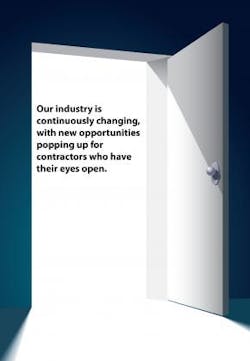You need to continue to add new programs and
repackage the old to keep the doors
opening in a tough economy.
Many of the buildings that I’ve personally been involved with are significantly below both ratings, with thousands of dollars to be saved. At the very least, this generates a strong interest in how to bring the building closer to the target numbers.
Much of the initial savings can be a result of the low-cost/no-cost improvements — the low-hanging fruit. Beyond this, you can offer an energy audit with associated recommendations for projects, control modifications, and improved maintenance tasking. As always, one-step-at-a-time selling is the best method.
One of the most common situations is dealing with the challenges of in-house maintenance staffs. Even though there are varying degrees of capabilities, it’s typical for in-house personnel to shun outside vendors in an attempt to protect their jobs. Split tasking is an innovative approach that will allow you to work with the in-house personnel instead of around them.
The first step is to determine how many tasks are being done in-house. This is accomplished through a detailed preventive maintenance tasking list of applicable samples such as packaged units, boilers, pumps, etc. This process usually uncovers numerous maintenance voids as a result of a lack of expertise, improper tooling, licensing, or simply a lack of manpower. Once you’ve reached agreement that there are voids in the present program, it’s fairly easy to get agreement on another meeting with the management personnel. I’ve also developed a template placing the in-house tasks in one column and the remainder in another. This creates a powerful, simple presentation for assuming tasks that aren’t being done in-house.
Selling points and benefits are:
• Removes voids in the present program
• Assists in managing the in-house staff
• Provides on-site training so in-house staff can eventually assume more tasks
• Provides task times to best use in-house employees
• Guarantees that the customer only pays for the tasks needed.
This may appear to be labor intensive, however, as soon as the templates and tasking lists are created, it’s simply cut-and-paste. I deliver a three-ring binder to the customer where both the in-house staff and our techs log the tasks as they’re completed. Initialing and dating the sheets provides a closed loop and more accountability.
The bottom line is that you need to continue to add new programs and repackage the old to keep the doors opening in a tough economy.
Earl King is the founder of King Productions International, a commercial HVAC contracting sales consulting firm based in Texas. He speaks to associations and trade groups, and writes a column for Contracting Business.com. Email Earl with any questions or comments at [email protected], or call him at 515/321-2426.
About the Author
Earl King
Consultant
Earl King is the founder of King Productions International, a commercial HVAC contracting sales consulting firm based in Texas. He speaks to associations and HVAC trade groups, and consults with commercial contractors across the country. E-mail Earl at: [email protected] or call him at 515/321-2426.

